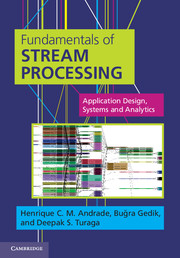Preface
Published online by Cambridge University Press: 05 March 2014
Summary
Stream processing is a paradigm built to support natural and intuitive ways of designing, expressing, and implementing continuous online high-speed data processing. If we look at systems that manage the critical infrastructure that makes modern life possible, each of their components must be able to sense what is happening externally, by processing continuous inputs, and to respond by continuously producing results and actions. This pattern is very intuitive and is not very dissimilar from how the human body works, constantly sensing and responding to external stimuli. For this reason, stream processing is a natural way to analyze information as well as to interconnect the different components that make such processing fast and scalable.
We wrote this book as a comprehensive reference for students, developers, and researchers to allow them to design and implement their applications using the stream processing paradigm. In many domains, employing this paradigm yields results that better match the needs of certain types of applications, primarily along three dimensions.
First, many applications naturally adhere to a sense-and-respond pattern. Hence, engineering these types of applications is simpler, as both the programming model and the supporting stream processing systems provide abstractions and constructs that match the needs associated with continuously sensing, processing, predicting, and reacting.
Second, the stream processing paradigm naturally supports extensibility and scalability requirements. This allows stream processing applications to better cope with high data volumes, handle fluctuations in the workload and resources, and also readjust to time-varying data and processing characteristics.
- Type
- Chapter
- Information
- Fundamentals of Stream ProcessingApplication Design, Systems, and Analytics, pp. xiii - xviiiPublisher: Cambridge University PressPrint publication year: 2014



